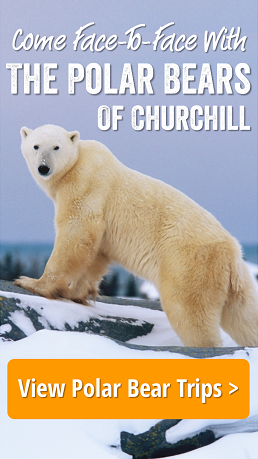by Steve Selden | Dec 9, 2013 | Tour News
Polar bear season is over for travelers to Churchill yet the real polar bear season is ongoing out on the Hudson Bay ice. Polar bears are hunting seals, mostly ringed seals, as the birthing season is building. While this goes on, Churchill is recouping and slowly settling in to the long winter. Seasonal workers have headed south for the winter with the exception of those brave few who will try to make it through to spring. Most restaurants and some hotels have closed for the season. Even many locals head out of town for some much needed relaxation and warmth before returning back home. Another amazing array of healthy polar bears and the return of good numbers of Arctic fox provided thrills for everyone involved in this year’s polar bear season. Here are some more photographs from this past fall…enjoy!
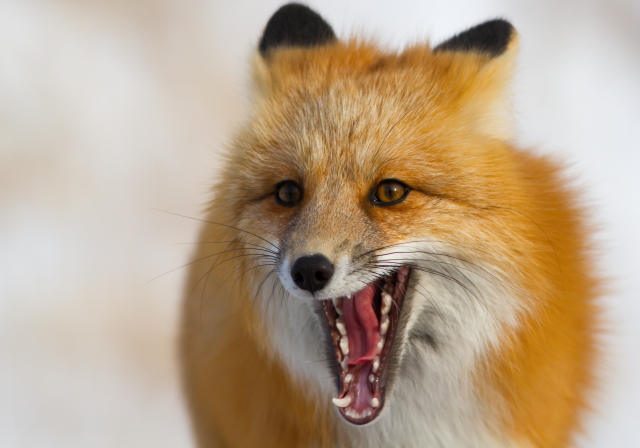
Red fox along the coast in Churchill,MB. Brad Josephs photo.
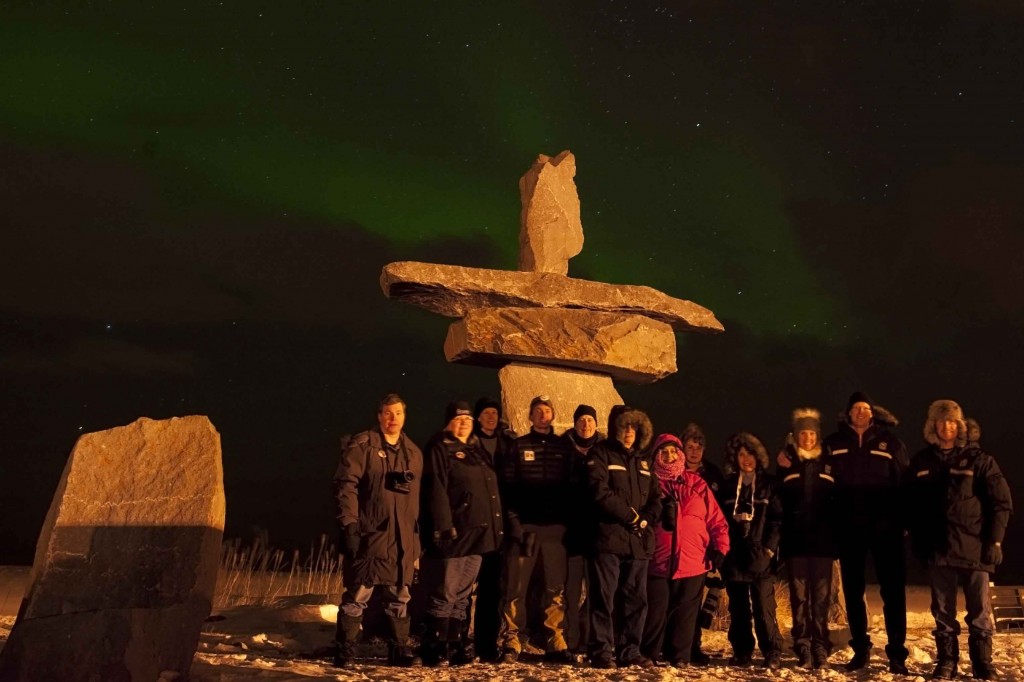
Inukshuk group photo with aurora over the bay. Colby Brokvist photo.

Two large polar bears waltz across the tundra in a sparring session. Eric Rock photo.
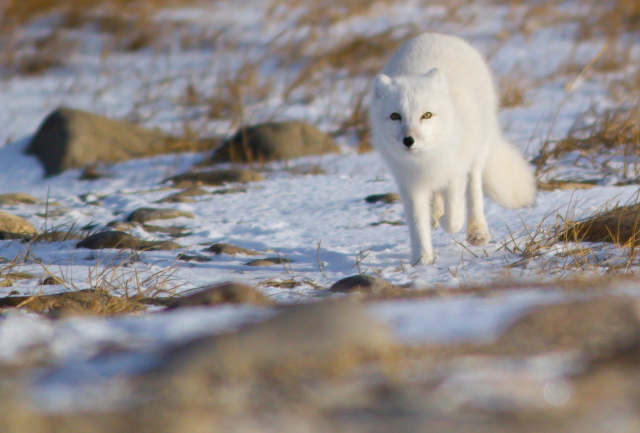
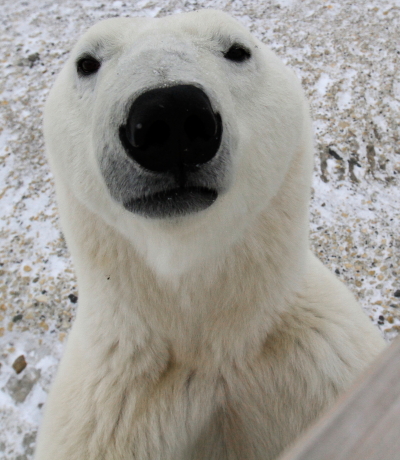

Snow covered Fort Prince of Wales. Karen Walker photo.
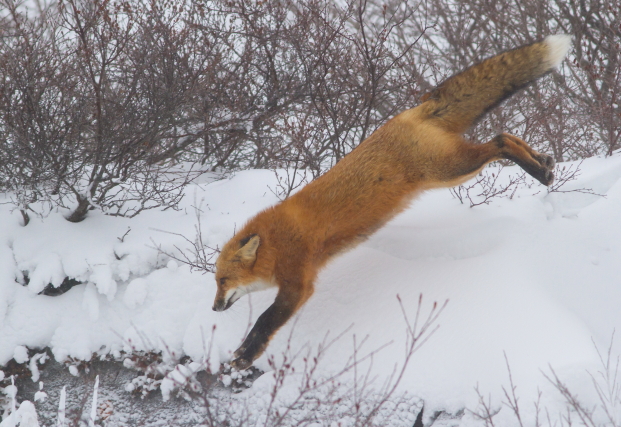

Polar bears sparring in the willows. Colby Brokvist photo.

by Steve Selden | Dec 4, 2013 | Tour News
I saw my first polar bear through a window. No, not at a zoo exhibit or aquarium or anywhere in captivity. My very first visit to Churchill, MB I saw the bear through the rear observation window in the town complex that looks down over the “beach”, a word used loosely in the north, and out across the Hudson Bay. With all the polar bears meandering wildly throughout the area you wouldn’t think seeing a bear from the comfort and warmth of the building would be too thrilling. It was.
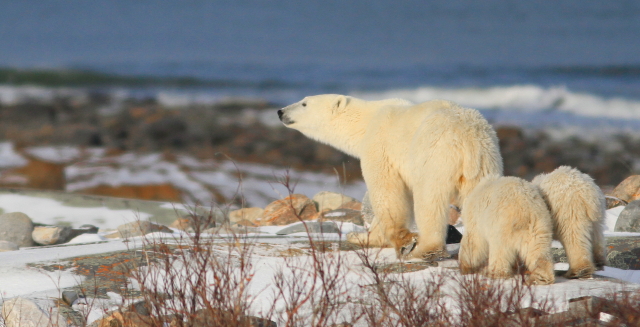
Sow and cubs along the Hudson Bay. Brad Josephs photo.
I was reading a report from Natural Habitat guide Karen Walker recently and she was explaining what her group was up to in the throes of some snow squalls, again words used loosely in the north, when they finally ended up at that same window viewing point in the complex. Here’s that account:
“Cape Merry was open, so we headed out there. Ranger Marcandre gave us some background on the fur trade then most of the guests ventured up to the “view point”. We could barely make out the icy river and definitely couldn’t see the Fort Prince of Wales. My intrepid guests headed out to the cannon battery for a brief visit and really got to experience the weather. It’s hard to imagine that the early explorers were able to survive in weather like this. Then we warmed up in the Town Complex. While we were up by the big window, by the Pioneer Gallery, a guest spotted a bear walking out on the ice, in the blowing snow. Then another bear appeared. They were heading toward each other. They veered away from each other and went their separate ways. Then one decided to head toward town, right toward the Enterprise (the wooden ship up in the beach-grass. The blowing snow cleared for a moment and we were able to see Bear Patrol parked by the inukshuk. The bear came closer, then they moved over by the Enterprise and fire- crackered it. It took off running, south along the shore. The other bear stayed out on the ice and headed south as well. It was really interesting to see it walking on the ice, but rolling up and down with the wind-driven swells. We never saw the bear close to shore again, but not too much later a bear was spotted in town, or near the castle. It might have been our bear.”
My experience wasn’t as dramatic though it was an incredible moment etched in my memory forever. As I gazed out across the ice -strewn bay, I saw the tell-tale yellow spot shifting over chunks of ice. Polar bears do not appear white when observed from such a distance and this one was quite small as I peered through the telescope mounted on the small ledge by the window. After some time, I was able to focus in quite nicely on the tiny bear maneuvering over the floes. Periodically the animal would step from solid ice to slushy leads and have to swim to the next floe. Watching this scene unfold touched the most primal instincts inside of me. In many ways it was more exhilarating then many of the hundreds of polar bear sightings I have witnessed since. Other than this being my first sighting, it was special because it was mine and only mine. From my mind to the polar bear across the expanse of ice I connected through my eyes only to a biological existence so unexplainable, how an animal could survive in this climate, that I felt this once in a lifetime experience deeper than most others.

Polar bear out on the isolation of the Hudson Bay ice enjoying a seal feast. Colby Brokvist photo.
I’ve since seen bears all over the tundra, boreal forest, in nets high above, in the compound, and in town. Yes they were exciting but in comparison up-close is not always better. The isolation of that lone bear surviving on the ice and in the frigid water will be frozen in my mind forever. It was and still is “my bear”.
by Steve Selden | Nov 22, 2013 | Tour News
Natural Habitat guide Karen Walker finished up the polar bear season with an enthusiastic and somewhat “seasoned” group. An initial day of dog sledding with Churchill River mushing and Kelly Turcotte provided one of those Arctic experiences that will last in memory forever. Gliding through the packed snow amongst covered spruce trees gave 89 yr old traveler Tina Vilhauer a thrill of a lifetime. She was able to share the experience with her granddaughter who also had a big smile.

Running sled dog. Brad Josephs photo.
After lunch the group was off via helicopter to scout out polar bear dens out near Wapusk National Park. Once located, the abandoned dens were another incredible, once in a lifetime event for most of the group. Tina and Muriel Slavens, a 75 year-old traveler were not able to forge across the snow to crawl through a den so the helicopter pilot hovered just above the entrance on the way back so they could get a closer look inside…a wonderful gesture for the women to cherish. Some of the other guests had crawled into the polar bear den and were able to describe the feel and earthly smell of the hollowed out tundra.
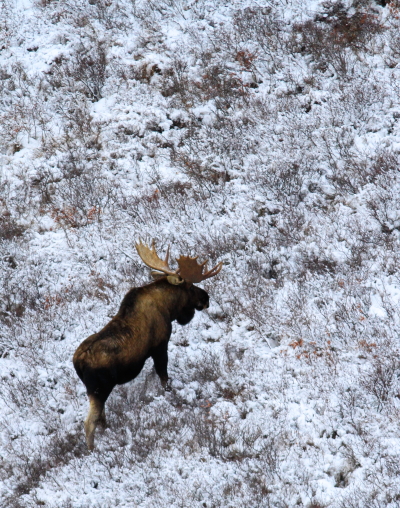
Moose moving along the tundra. Brad Josephs photo.
As the group flew across Wapusk National Parc, along the Churchill River they searched the land for moose… spotting quite a few, including a sow and calf and four large bull moose in a group together. As they headed up the coast searching for polar bears all aboard noticed that the ice had really packed into the Hudson Bay the last few days, so it was difficult to spot the bears.There were no bears at Cape Churchill yet…traditionally the last stepping -off point of the season for polar bears heading out onto the ice to hunt seals. Finally heading west, they spotted several bears, including a sow with cubs. Bears waiting by leads of water in the ice for seals and one blood stained patch of ice with indented paw prints around signaled the scene of an earlier seal kill. Returning to town the choppers flew into the sunset, with a hazy, foggy orange sky ahead and a sun dog rainbow off to the side. The final leg took the group over the Ithaca ship wreck encased in the ice in Bird Cove heading back into Churchill at last light. Back in town after a hot dinner the group enjoyed an inspiring talk by local Metis elder Myrtle Demeulles.

Snow covered Fort Prince of Wales. Karen Walker photo.
The first morning out on a rover produced very little wildlife activity until the group reached a point out east. There a healthy polar bear lumbered along the coast, very close to the rover. Several more bears were spotted out on the ice and then a few minutes of sparring at the tundra lodge. A bear nearby the lodge was licking at its paws for quite awhile. Four other sleeping bears were in view and the tranquility of the animals mixed with the majestic landscape was satisfying to all travelers aboard. The group caught a great view of an arctic fox along the coast …following it with the rover for several minutes.

Arctic fox combing the tundra. Brad Josephs photo.
The following day was stormy so polar bears were either hunkered down in the willows or facing the challenges of being out on the sea ice of the Hudson Bay in search of seals. A bear was spotted along the ice edge at the coast walking slowly . “We did get to see an arctic fox as we left town in the morning, an arctic hare in the willows in Ptarmigan Alley and some ptarmigan popping up and down along a snow berm near the lodge lake. So we ended up seeing all 4 arctic animals that day which is pretty unusual., reported Karen.
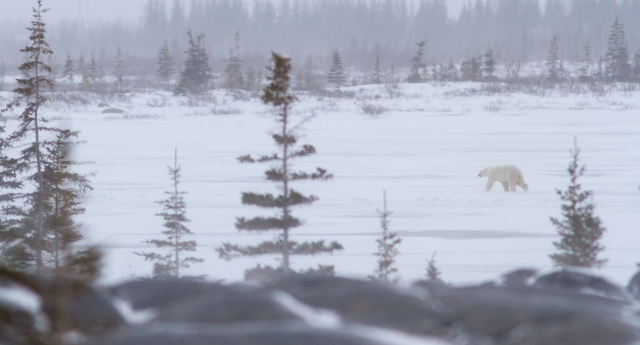
Polar bear walking along a frozen thermokarst. Brad Josephs photo.
“Our last morning was beautiful, so we drove around as far as we could without getting stuck in the snow drifts. We couldn’t get all the way to Cape Merry, but we got beyond Jockville and could see Fort Prince of Wales across the frozen Churchill River. We saw lots of fresh bear and fox tracks, but none were in sight.”, stated Karen. A magnificent morning around the Churchill area.

Calm Air charter ready to fly to Winnipeg. Karen Walker photo.
Just before the groups flight to Winnipeg, they got to see a bear lift of a sow and her two cubs. The cubs rode in the cab of the helicopter with seat belts fastened to hold them secure while mom was slung underneath in the cargo net. The guests really enjoyed that grand finale.
by Steve Selden | Oct 23, 2013 | Tour News
News from the Tundra Lodge came early with a “house bear” as Natural Habitat guide Leah McGowan dubbed him. The lone polar bear set up shop immediately and slept the first week away with periodic displays of energy spurred on possibly from wafting gourmet scents from the kitchen car. He was promptly named ‘Frances’ after a guests daughters cuddly childhood polar bear, of the same name.

Arctic fox inquisitive of travelers. Colby Brokvist photo.
The bear is a mature male with several scars on his nose and another scar above his right eye. He is lean, though not skinny. He seems like an ‘old soul’ wise and patient…. looking up at you with knowing eyes.
By night three for the inaugural lodge group, four, maybe five bears in addition to Frances had wandered into the area. All seemed to be getting along just fine after a few “discussions” on personal space.
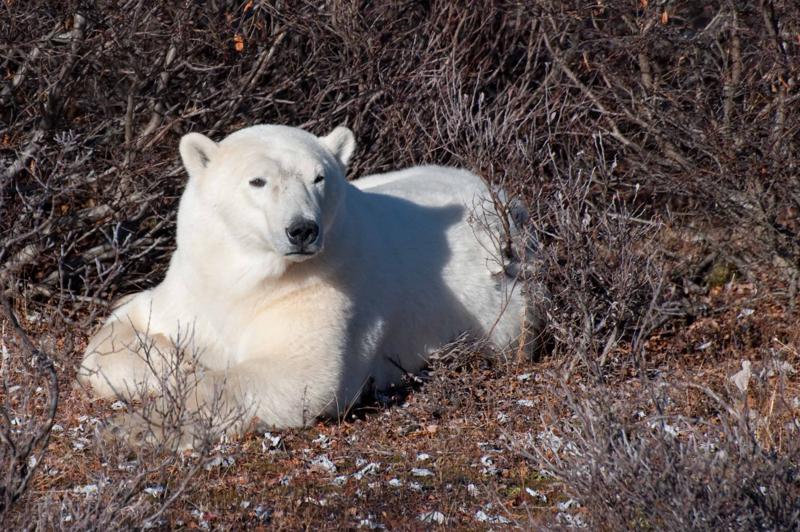
Photo: Colby Brokvist
The tundra still sporting browns and reds awaits the snow soon to come from the north.
Guide Colby Brokvist reporting from Winnipeg after a “wonderful” early season trip gave rave reviews of all facets of his groups’ adventure. A tri -fecta of foxes graced the travelers presence with red, Arctic and even a rare silver sighting. Out at the lodge there have been at least two a night on a steady basis.
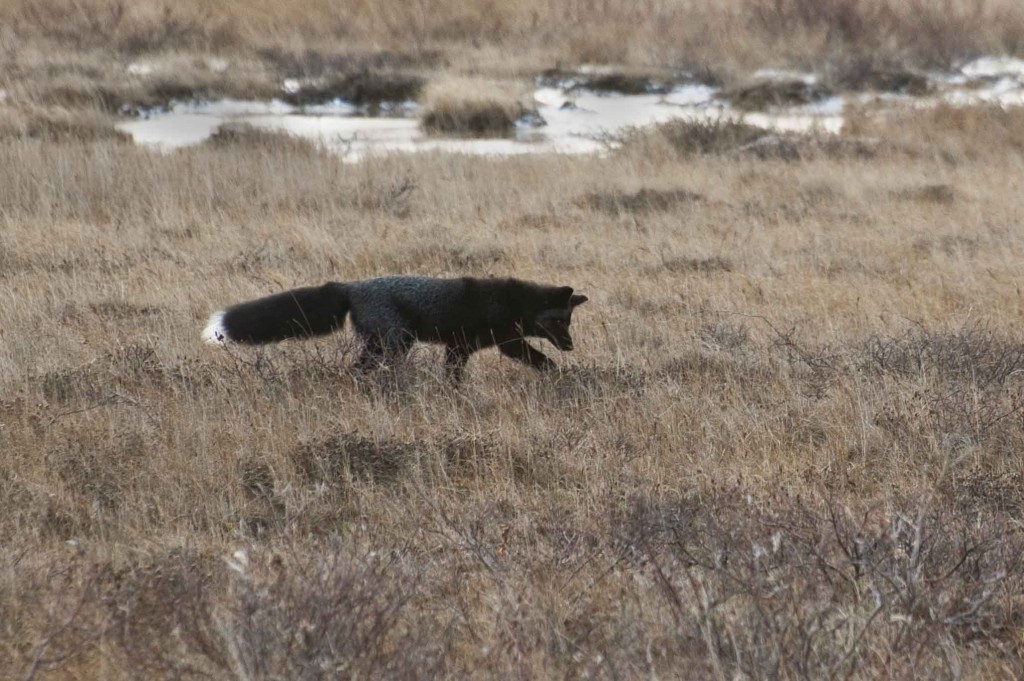
Silver fox scouring tundra for lemmings. Colby Brokvist photo
Truly the highlight of this past week’s wildlife log was a pair of beluga whales just off the rocky coast of Cape Merry. Amazing to spot these babies this late in the season. Imagine being able to combine summer trips with polar bear season? You could get it all at once. Give global warming some time it might happen.
Gordon Point provided some fine entertainment one day with a ringed seal swimming teasingly at a risky distance from white furred bears. Where else on the planet can you find that kind of drama?
Bird-wise…a list of 23 deep included harlequin ducks and a gyrfalcon….both rare for early season trips. So far an off year for snowy owls..still time though. The air has transitioned to the next level of cold which shall digress another 10 notches before the Hudson Bay Quest arrives in March. Cold enough though for most shallow thermakarst ponds to have a healthy icy veil on their surface….not quite strong enough to support an 800 pound animal.
The “port report” …still oil free..has two ships in port and two anchored out at five -fathom hole in the Hudson Bay. Workers are banking overtime hours trying to beat mother nature before she freezes over the Hudson Straits in the far northeast corner of the bay, sealing off the escape route for outgoing vessels. A long winter awaits.
by Steve Selden | Sep 23, 2013 | Churchill News
Omintrax Canada’s plan to move a test shipment of Alberta crude oil through northern Manitoba to the Port of Churchill next month has been put on hold by Manitoba Transportation Minister Steve Ashton. It’s a harsh blow to the company’s hopes to move nearly 3.3 million barrels of crude through the port as early as next year.
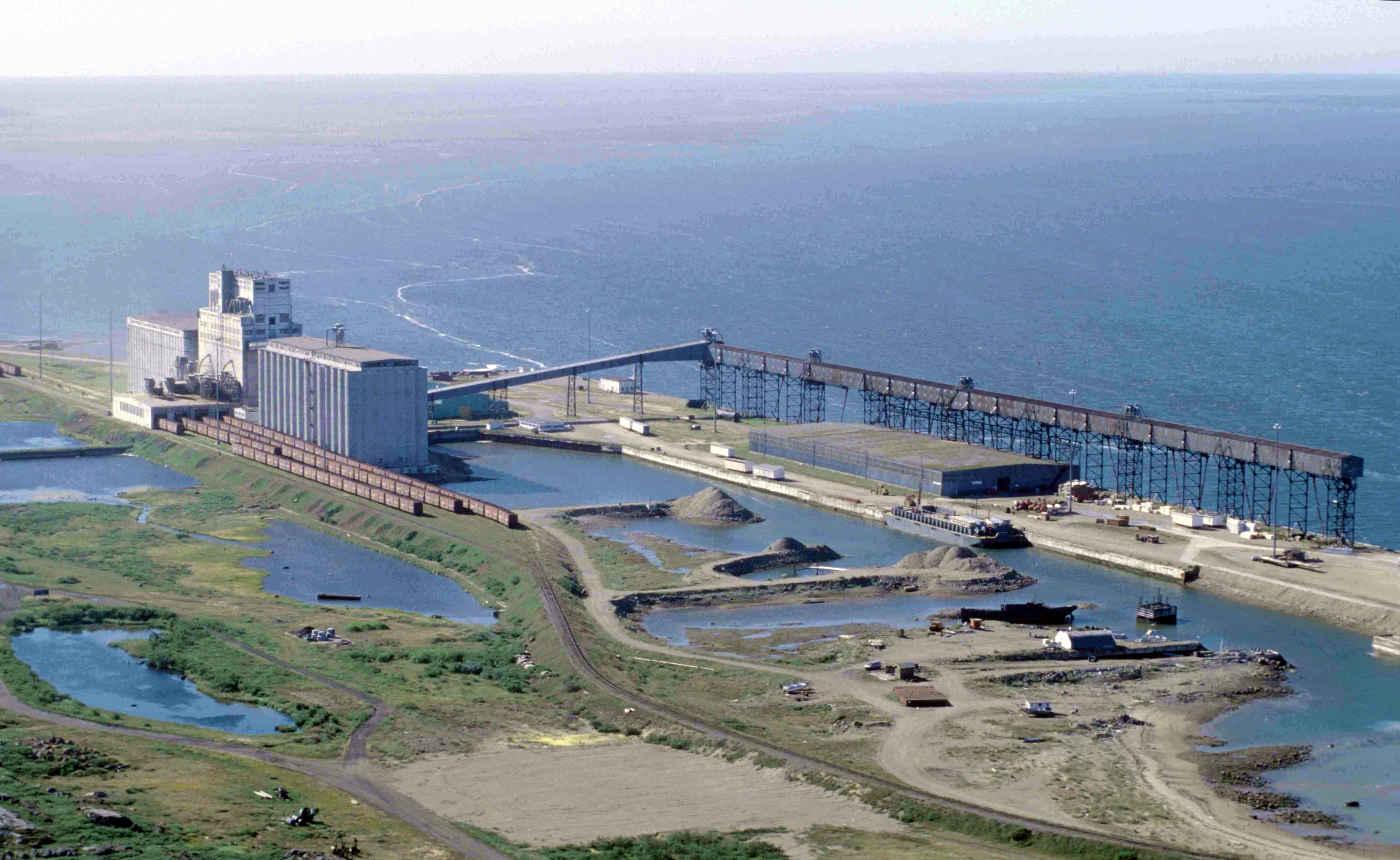
Shipping oil over the Hudson Bay is a new avenue for growth harboring hopes to expand Churchill’s role as an Arctic gateway.
However, apparently Mr. Ashton is seeing beyond the potential economic benefits to the area and port itself and erring quite wisely on the side of caution on this issue. The Hudson Bay is an extremely sensitive ecosystem that also has current economic and life sustaining benefits to all the communities that reside on its’ fragile coastline. One tragic accident could destroy the Hudson Bay and all the creatures that rely on the body of water for life itself for decades to come. A comprehensive study and subsequent operating plan must be in place before one drop of oil is shipped via this new proposal. Currently some oil is shipped north on barges to sustain Nunuvut communities but in no comparison to the amounts being projected in this international endeavor.
Proponents of the plan stress that oil is already shipped all over the continent by rail, truck and pipeline, and far more dangerous goods have moved regularly on the line for decades. However, shipping over land is far less dangerous and risky than transporting over water…especially so for water that is regularly in the 42 degree F temperature range. Couple that with weather that is unpredictable and harsh much of the year and a clean-up mission in these conditions would be nearly impossible.
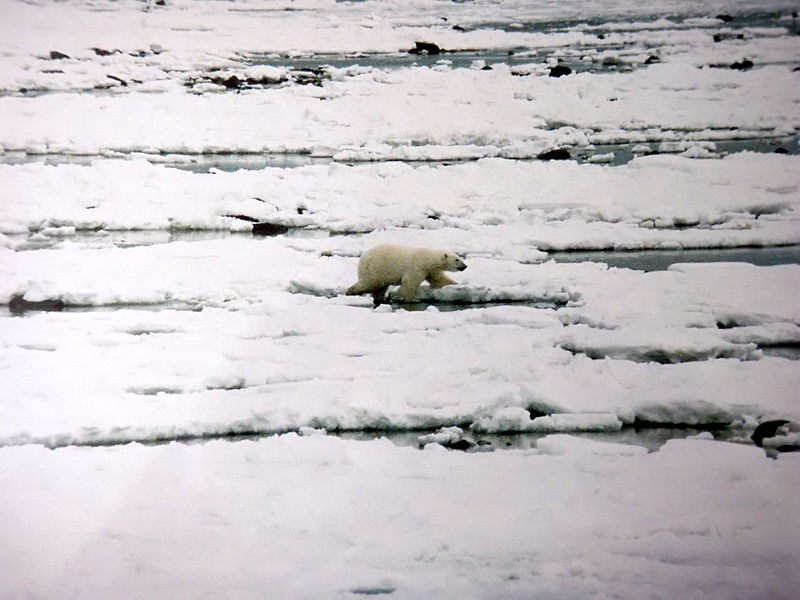
Mr. Ashton advised Omnitrax to “go back to the drawing board on this,” holding some hope for the company to be able to explore options in the future. In this case the risk of any oil being transported over the bay seems insurmountable.
The Wilderness Committee interpreted Mr. Ashton’s comments as a rejection of Omnitrax’s plans and issued a statement Friday congratulating the Selinger government for offering “exactly the response we were hoping for.” As far as they are concerned, the plan is dead.
The disaster at Lac-M©gantic, where 47 people were killed after a train carrying oil crashed and exploded was cited by the Minister as a reason to be concerned about Omnitrax’s plans.

Lac-Megantic burning on the first day after the rail car derailment sent fireballs and streams of burning oil coursing through the Quebec village. (Photo: Surete du Quebec)
Omnitrax is convinced its’ northern rail lines don’t need upgrades to carry oil and the idea of shipping the liquid across the tundra is safe. This opinion flies directly in the face of the numerous grain car derailments that have occurred over the past two decades on those exact lines…at least the birds and some other animals can eat grain when it spills. Although federal approval for the rail shipping plan is required since railways are federally regulated, provincial opposition could be a barrier for such approval.























